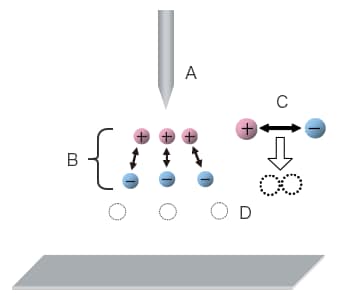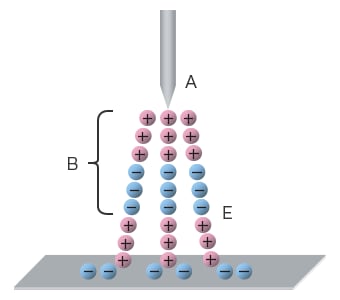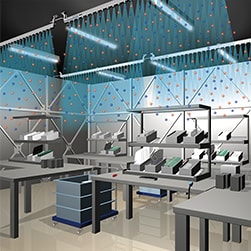Static Elimination in Large Spaces
Anywhere objects rub against each other is commonly considered to be a place where static electricity is generated. However, static electric charge can be created from anything, including moving objects and people. Slight static electricity can spread across an entire room.
Here, we explain the principle of eliminating static electricity generated in large spaces and introduce case studies on this topic.
- What is static elimination in large spaces?
- Principle of eliminating static electricity from a space
- Example of eliminating static electricity from a space using a static eliminator (ionizer)
What is static elimination in large spaces?
Static electricity is generated when objects are moved or when people walk or move. Therefore, any place where there is human traffic or any space used for transporting parts is constantly electrically charged.
For example, static electricity is constantly generated in cleanrooms and warehouses that store electronic components. Therefore, the entire space must be made static-free in order to prevent adhesion of foreign particles and destruction of parts due to static electricity. This is static elimination in large spaces.
Principle of eliminating static electricity from a space
Positive and negative ions generated by a static eliminator (ionizer) disappear when they bond together, losing static elimination effect. Therefore, to eliminate static from large spaces, the neutralising ions must be carried long distances without the positive and negative ions binding.
When the ion generation cycle is short, positive and negative ions switch rapidly,* which causes ions with opposite polarities to be attracted to each other and prevents them from traveling any significant distance. In contrast, a longer ion generation cycle makes for longer emission time of ions of the same polarity, which repel each other and spread over wider areas.
Making the static eliminator (ionizer) produce positive and negative ions at a longer cycle so that they don’t bond and can spread easily allows for static elimination of a wider area.
This phenomenon, called rebonding, occurs when positive and negative ions bond together, causing both ions to disappear.
- Short ion generation cycle
-

- Long ion generation cycle
-

- A: Electrode probe
- B: Ion generation cycle
- C: Rebonding
- D: Disappear
- E: Reach
Example of eliminating static electricity from a space using a static eliminator (ionizer)
Pulse AC method or Pulse DC method bar type ionizers are effective for delivering ions throughout a wider space. A bar type static eliminator can neutralise a wide area of space, an entire room for example, that has airborne foreign particles. By delivering ions throughout the entire room and removing electrostatic charge from airborne foreign particles, the ionizer can prevent them from adhering to surfaces.
Case 1: Static elimination during air showers
The human body collects hair and dust. In an air shower, the blown-off dust can reattach itself to human bodies. Using a bar type ionizer in front of the entrance to a static-free site can prevent static charge and foreign particles from being brought in by operators. This static elimination approach can be effectively used at the entrance of any cleanroom of a semiconductor manufacturing plant or precision machining factory.

Case 2: Measures against foreign particles floating in large spaces
A bar type static eliminator (ionizer) can be used for a large space where airborne foreign particles are present, in order to eliminate static across the entire room. Eliminating static charges in the entire room can also neutralise charges on foreign particles and prevent them from adhering to surfaces. This approach is useful for countering electrostatic discharge (ESD) and surges at warehouses that store semiconductor devices.








